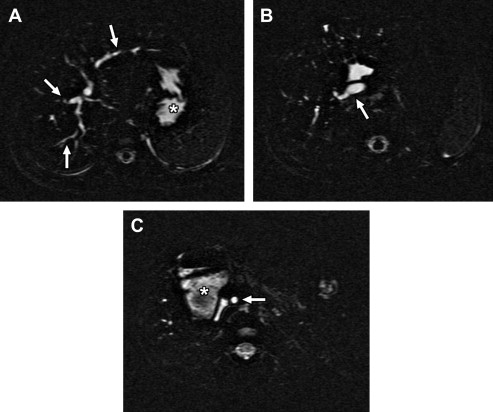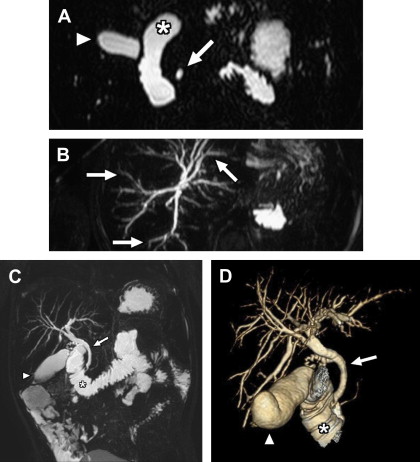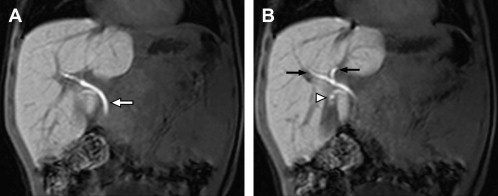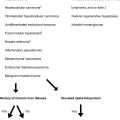Magnetic resonance cholangiopancreatography (MRCP) is an extremely useful tool for evaluating a wide variety of disorders affecting the pancreaticobiliary system in neonates/infants, children, and adolescents. This imaging technique has numerous distinct advantages over alternative diagnostic modalities, such as endoscopic retrograde cholangiopancreatography and percutaneous transhepatic cholangiography, including its noninvasive nature and lack of ionizing radiation. Such advantages make MRCP the preferred first-line method for advanced imaging the pediatric pancreaticobiliary tree, after ultrasonography. This article presents a contemporary review of the use of MRCP in the pediatric population, including techniques, indications, and the imaging appearances of common and uncommon pediatric disorders.
Key points
- •
Magnetic resonance cholangiopancreatography (MRCP) uses heavily T2-weighted MR imaging pulse sequences to visualize fluid (pancreatic fluid and bile, respectively) within the pancreaticobiliary system. This technique is referred to as MR hydrography .
- •
MRCP has several distinct advantages over alternative imaging techniques, such as endoscopic retrograde cholangiopancreatography and percutaneous transhepatic cholangiography, including its noninvasive manner and lack of ionizing radiation.
- •
Three-dimensional (3D) MRCP has distinct advantages over traditional 2-dimensional (2D) MRCP techniques, including better signal-to-noise and contrast-to-noise ratios, improved spatial resolution, and the ability to create a variety of 2D multiplanar reformations and 3D reconstructions.
Introduction
Magnetic resonance cholangiopancreatography (MRCP) is an extremely useful tool for evaluating a wide variety of disorders of the pancreaticobiliary system in pediatric patients of all ages, including neonates/infants, children, and adolescents. MRCP has been shown to have good diagnostic accuracy in both children and adults ; it has distinct advantages over alternative imaging techniques, such as endoscopic retrograde cholangiopancreatography (ERCP) and percutaneous transhepatic cholangiography. The advantages include the lack of ionizing radiation, the ability to thoroughly image the hepatic and pancreatic parenchyma in addition to the pancreaticobiliary tree, and the capability for the generation of 2-dimensional (2D) multiplanar reformations and 3-dimensional (3D) reconstructions. MRCP is also noninvasive with no risk of causing acute pancreatitis, allergic-like reactions to iodinated contrast material, or bleeding. For all of these reasons, MRCP is now the preferred first-line advanced imaging test for assessing the pediatric pancreaticobiliary system, after ultrasonography.
The purpose of this article is to provide a contemporary review of pediatric MRCP, including techniques and indications. Additionally, the authors present the imaging appearance of numerous common and uncommon conditions affecting the pediatric pancreaticobiliary system, such as choledocholithiasis/cholelithiasis; choledochal cysts; stricturing disorders (eg, sclerosing cholangitis, anastomotic strictures, and ischemic strictures); biliary neoplasm; biliary congenital anatomic variants; and abnormalities of the pancreatic ducts (caused by congenital anatomic variants, pancreatitis, and trauma).
Introduction
Magnetic resonance cholangiopancreatography (MRCP) is an extremely useful tool for evaluating a wide variety of disorders of the pancreaticobiliary system in pediatric patients of all ages, including neonates/infants, children, and adolescents. MRCP has been shown to have good diagnostic accuracy in both children and adults ; it has distinct advantages over alternative imaging techniques, such as endoscopic retrograde cholangiopancreatography (ERCP) and percutaneous transhepatic cholangiography. The advantages include the lack of ionizing radiation, the ability to thoroughly image the hepatic and pancreatic parenchyma in addition to the pancreaticobiliary tree, and the capability for the generation of 2-dimensional (2D) multiplanar reformations and 3-dimensional (3D) reconstructions. MRCP is also noninvasive with no risk of causing acute pancreatitis, allergic-like reactions to iodinated contrast material, or bleeding. For all of these reasons, MRCP is now the preferred first-line advanced imaging test for assessing the pediatric pancreaticobiliary system, after ultrasonography.
The purpose of this article is to provide a contemporary review of pediatric MRCP, including techniques and indications. Additionally, the authors present the imaging appearance of numerous common and uncommon conditions affecting the pediatric pancreaticobiliary system, such as choledocholithiasis/cholelithiasis; choledochal cysts; stricturing disorders (eg, sclerosing cholangitis, anastomotic strictures, and ischemic strictures); biliary neoplasm; biliary congenital anatomic variants; and abnormalities of the pancreatic ducts (caused by congenital anatomic variants, pancreatitis, and trauma).
Pediatric MRCP techniques
MRCP most commonly uses a variety of heavily T2-weighted pulse sequences that allow visualization of fluid (pancreatic fluid and bile, respectively) within the pancreaticobiliary system (also known as MR hydrography ). By using heavily T2-weighted fat-saturated pulse sequences, materials/tissues with longer T2 relaxation times appear markedly hyperintense (eg, fluid), whereas materials/tissues with shorter T2 relaxation times (eg, hepatic and pancreatic parenchyma) appear relatively hypointense.
A variety of 2D and 3D techniques have been used to successfully image the pancreaticobiliary tree. Traditionally, MRCP protocols have been comprised of thin-section and/or thick-slab 2D single-shot fast spin-echo (SSFSE) pulse sequences. Coronal and axial thin-section images allow for cross-sectional assessment of the biliary and pancreatic ducts, with detailed assessment of the ducts themselves and the presence of filling defects ( Fig. 1 ). Thick-slab images provide an overview of the pancreaticobiliary system and can be obtained in any projection. Commonly, multiple thick-slab coronal-oblique images are acquired that are radially oriented around the pancreatic head. However, 2D SSFSE MRCP images are limited by
- •
Relatively poor spatial resolution
- •
Low signal-to-noise ratio
- •
Inability to create isotropic (or near-isotropic) 2D multiplanar reformations (in any plane) and 3D reconstructions (in any orientation) ( Box 1 ).
Box 1
Higher signal-to-noise ratio
Higher contrast-to-noise ratio
Improved spatial resolution
Thin-section isotropic images
Ability to create
- •
2D multiplanar reformations
- •
3D reconstructions
Advantages of 3D MRCP versus 2D MRCP

Three-dimensional T2-weighted fast spin-echo (FSE) MRCP imaging overcomes the 2D MRCP limitations mentioned earlier (See Box 1 ). Because these sequences typically take several minutes to acquire (even when parallel imaging is used), respiratory triggering or navigator (diaphragmatic) gating is required. The fast recovery FSE (FRFSE) technique is also commonly used when using 3D MRCP to provide high signal intensity from fluid and increased image contrast while reducing overall imaging time (FRFSE allows a shorter repetition time because of a negative 90° pulse that causes much faster recovery of tissues with long T2 time to the equilibrium). Three-dimensional MRCP allows for 2D multiplanar reformations in an infinite number of planes as well as a variety of 3D reconstructions (most commonly volume-rendered and maximum-intensity projection images) ( Fig. 2 ).

A standard pediatric MRCP protocol could include any of the following pulse sequences:
- •
Thin-section (3–6 mm) SSFSE with fat-saturation (coronal and/or axial)
- ○
Breath held or respiratory triggered
- ○
- •
Thick-slab (4–8 cm) SSFSE with fat saturation (any coronal-oblique plane)
- ○
Breath held
- ○
- •
Isotropic (near-isotropic) 3D T2-weighted FRFSE with fat saturation (coronal)
- ○
Respiratory triggered or navigator gated
- ○
Depending on the clinical indication, a variety of additional pulse sequences may prove complimentary. At the authors’ institutions, they commonly include the following pulse sequences as part of the standard pediatric MRCP protocol:
- •
Coronal (5 mm) SSFSE
- ○
Respiratory triggered
- ○
- •
Axial (5 mm) T2-weighted FSE with fat-saturation
- ○
Respiratory triggered
- ○
- •
Axial (5 mm) T1-weighted gradient recalled echo (GRE) in and out of phase
- ○
Breath held
- ○
- •
Axial (2–3 mm) dynamic and delayed postcontrast 3D T1-weighted spoiled GRE (SPGR) with fat saturation
On occasion, delayed postcontrast T1-weighted 3D SPGR imaging using a hepatocyte-specific contrast material, such as gadoxetate disodium (Eovist), may prove useful for evaluating the biliary tree. For most patients, in the absence of biliary obstruction, excreted T1-weighted hyperintense contrast material can be seen within the biliary system, including intrahepatic and extrahepatic bile ducts, the cystic duct, and the gallbladder, in about 10 to 30 minutes ( Fig. 3 ). With time, excreted contrast material is eventually visualized in the duodenum and more distal small bowel. This form of MRCP may be particularly helpful when evaluating for bile duct injury (including traumatic/anastomotic leak or biloma), questionable biliary obstruction in the setting of mild bile duct dilatation, and when attempting to determine if cystic structures located within the liver or porta hepatis communicate with the biliary system ( Box 2 ).

Evaluation for bile duct injury
- •
Trauma
- •
Anastomotic leak
- •
Biloma
- •
Evaluation for biliary obstruction in setting of mild bile duct dilatation
Determining whether an intrahepatic or perihepatic cystic structure communicates with the biliary tree
In the authors’ experience, for certain cases, more delayed imaging after several hours may prove useful to increase diagnostic accuracy (for example, when looking for contrast material in a perihepatic fluid collection suspected to be a biloma). A study by Ringe and colleagues in adult patients concluded that this form of MRCP “adversely affects respiratory-triggered 3D MR cholangiography, both qualitatively and quantitatively,” and they concluded that 3D T2-weighted MRCP imaging should be performed before injection of gadoxetate disodium. Another disadvantage of MRCP using a hepatocyte-specific contrast material is that this agent generally does not fill the pancreatic duct, thereby limiting its evaluation.
The intravenous injection of secretin immediately before MRCP has been described as a potentially beneficial adjunct maneuver. Secretin stimulates secretion of bicarbonate-rich pancreatic fluid and, in theory, could improve visualization of the pancreatic duct. However, a recent study by Trout and colleagues assessing the effect of secretin on pediatric patients undergoing MRCP imaging concluded that this medication “induces dilatation of the pancreatic duct but the value of that effect in pediatric MRCP is suspect given the small change in duct diameter and the lack of improvement in image quality and duct visibility.” At the authors’ institutions, they do not routinely administer secretin when performing pediatric MRCP.
Discussion
Cholelithiasis and Choledocholithiasis
The incidence of both cholelithiasis and choledocholithiasis is increasing in the pediatric population. A variety of conditions that affect children of all ages are associated with gallstone formation, including the following:
- •
Obesity
- •
Hemolytic disorders
- •
Total parenteral nutrition
- •
Cystic fibrosis
- •
Terminal ileitis caused by Crohn disease
Although ultrasound is the preferred test for diagnosing cholelithiasis, MRCP can also identify the presence of gallstones and may be particularly helpful in cases in which sonographic evaluation of the gallbladder is limited. MRCP can also identify potential complications of cholelithiasis, such as cholecystitis or Mirizzi syndrome. Gallstones on MRCP typically appear as low-signal filling defects within hyperintense bile on T2-weighted imaging. On T1-weighted imaging, gallstones may appear either hypointense or hyperintense depending on their composition (pigmented stones are usually hyperintense, whereas cholesterol stones are hypointense) ( Fig. 4 ). Careful attention should be paid to the gallbladder neck to avoid missing gallstones lodged in this region. In pediatric patients with cholelithiasis, the presence of pericholecystic fluid and/or gallbladder wall thickening on T2-weighted imaging should raise suspicion for cholecystitis ( Fig. 5 ).

Choledocholithiasis can arise either from calculi forming in situ within the biliary tree or from the passage of gallstones into the extrahepatic bile ducts from the gallbladder. Although the sensitivity of ultrasound for detecting cholelithiasis is high, ultrasound is not as reliable for detecting choledocholithiasis because visualization of the common hepatic and common bile ducts can be limited (for example, because of shadowing from overlying bowel gas). Fortunately, MRCP is generally sensitive for detecting choledocholithiasis, with a reported sensitivity in adults of 88% to 92% by Becker and colleagues and 95% confidence interval by Nandalur and colleagues. Potential complications of choledocholithiasis that MRCP can also identify include associated biliary obstruction, ascending cholangitis, and acute pancreatitis caused by obstruction of pancreatic drainage. At MRCP, choledocholithiasis most often presents as a low-signal focal filling defect in the intrahepatic or extrahepatic bile ducts on T2-weighted imaging, best seen on thin-section axial or coronal SSFSE or 3D MRCP coronal source or axial reformatted images. Biliary calculi can be easily obscured on thick-slab SSFSE images or 3D MRCP volume-rendered or maximum intensity projection (MIP) reconstructions. Kim and colleagues found that the addition of T1-weighted GRE imaging to standard MRCP pulse sequences increases detection of intrahepatic biliary calculi.
Choledochal Cysts
Choledochal cysts are a rare congenital anomaly of the biliary tree characterized by focal, abnormal dilatation of a bile duct (or ducts). Biliary involvement can be intrahepatic, extrahepatic, or both. Classically, choledochal cysts are characterized using the Todani classification system (types 1–5) ( Table 1 ). There are several potential complications associated with choledochal cysts, including choledocholithiasis, cholangitis, and rarely cholangiocarcinoma. Although ultrasound readily detects many choledochal cysts, MRCP is often required for definitive characterization. Specifically, MRCP allows for the following:
- •
Precise Todani classification of the choledochal cyst (or cysts)
- •
Exact measurement of cyst size (including extent of intrahepatic/extrahepatic biliary tree involvement and relation to the cystic duct)
- •
Detection of intraluminal filling defects (most often debris or calculi and rarely neoplasm)
| Type | Findings |
|---|---|
| Ia | Cystic dilatation of the extrahepatic bile duct |
| Ib | Focal cystic dilatation of the extrahepatic bile duct |
| Ic | Fusiform dilatation of the CBD |
| II | CBD diverticulum (saccular outpouching) |
| III | Cystic dilatation of the intraduodenal portion of the CBD (ie, choledochocele) |
| IVa | Dilatation of extrahepatic bile duct with involvement of intrahepatic bile ducts |
| IVb | Multiple cystic dilatations involving the extrahepatic bile duct |
| V | Dilatation involving only intrahepatic bile ducts (Caroli disease/syndrome) |
Choledochal cysts appear as either fusiform or saccular areas of cystic (T2-weighted hyperintense) biliary ectasia/dilatation and can be readily identified using both 2D and 3D MRCP techniques ( Figs. 6–8 ).

Stay updated, free articles. Join our Telegram channel

Full access? Get Clinical Tree




